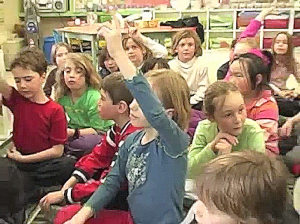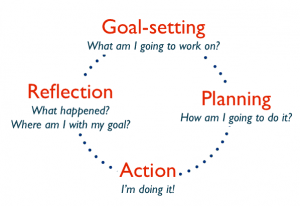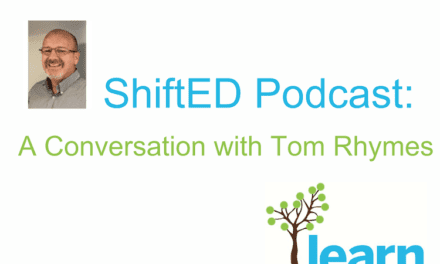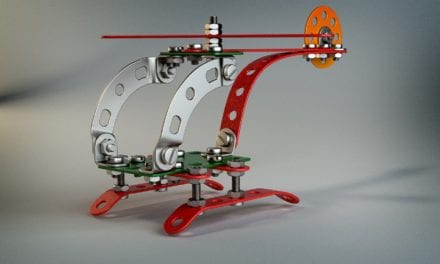“I believe that the theme ‘again and again’ is paramount in cycle one. Children (people) don’t always ‘get it’ on the first round, or second, or third. Children love to do the same activity again and again.” Peter Simons, Cycle 1 teacher, CQSB
Here’s the good news: children in Cycle One (grades one and two for those of you unfamiliar with the Quebec system) can set goals and reflect on their learning. I’ll say it again: six- and seven-year-old children can discuss what they did in the past, they can make plans for the future and can look back at their progress. I’ve seen their goals and heard their reflections in classrooms across the province. More importantly, teachers say that engaging in conversations about learning and not just about WHAT they are learning helps their students succeed in class. So why are some educators reluctant to embrace the practice of reflection and its alter-ego, goal setting? Misconceptions and misunderstanding abound, as many workshops on the topic target older learners, which leads Cycle One teachers to wonder if its even possible with their young students…and what it might look like in their classrooms.
Defining the terms
Reflection is thinking for the purpose of analyzing and evaluating our learning. We often talk of reflection in the context of portfolio practice, that is, in the context of using a process-based device for tracking student learning and growth over time, such as a portfolio. But even if you do not use portfolios with your students, you can still use the reflection cycle to improve your students’ awareness of their own learning. Goal-setting is part of the reflective learning cycle, and allows the learner to plan a focus for their learning.
So, with the intent of providing some pathways for exploring reflection and goal-setting with young learners, here are 5 myths about these practices and some reasons to let them go to the big myth graveyard in the sky:
Myth 1 – How can they set goals and reflect – they can’t even write!
This is an easy one and immediately obvious to most Cycle 1 teachers, who are very used to dealing with early- or non-readers and writers. What do we do when our learners can’t write? We talk, of course! We talk during circle time, we talk one-on-one, we talk in groups, we talk in pairs! We talk about what worked, what didn’t and why. We talk about our plans and the choices we make when we enact our plan. Planning and choosing are precursors to the goal-setting process, or as Epstein (2003) puts it, “planning is choice with intention” (emphasis in original) which is based on a goal. The other thing we do in Cycle 1 in addition to talking is drawing! Children can make regular representations of things that occurred or things that are to come, such as planning out a project or an activity. Over time, this planning can become more purposeful and tied to each student’s individual learning path, but it rarely starts out that way. In fact, by engaging in daily planning and reflecting conversations and visual representations (drawings, diagrams, etc), the Cycle 1 teacher can help lay the foundation for future self-reflection and goal-setting tied to learning, just as she helps to lay the foundation for lifelong literacy.
Myth 2 – Students don’t get what they are doing – reflection and goal-setting are just too abstract!
Lots of things are quite abstract, but that shouldn’t prevent us from taking the first steps to understanding, right? Moreover, while the concepts of goal-setting and reflection on learning might be abstract, the habits involved are actually quite concrete. Sitting with your students during circle time is one way to look back on an activity and to set goals for another one. Let’s use writing as an example activity:
With your students sitting together on the floor, you may ask them what kinds of things they remember about writing from recent activities. Students might say things like:
- “we learned about capitals”
- “putting a dot at the end”
- “making a space between the words”.
You can write these down on a flip-chart or on the board (whatever you usually do) and suggest some goals of your own that are important to you, such as: “let’s use a new word” or “let’s use a word from the Word Wall” or whatever you happen to be working on at the time. Ask students what their goals will be and listen to a few students. This will allow students who don’t quite get it to listen to other children work through goal setting. When its time to reflect, students will have something specific to say about their work – they either met the goals set out, or they didn’t and it will be easy to see. In Cycle One you might not hear sophisticated metacognitive discourse, but you will be developing habits of mind that will prove useful once metacognition kicks in.
Myth 3 – Goal-setting and reflection are for older kids
I was reading over some research data and came across a goal set by a grade one student who wanted to learn to ties his shoes. This was his global goal, and not one related to any specific assignment or activity. It was clearly important to him in his life, and I bet he had more where that came from. I could picture him sitting at his desk thinking about what he intends to get done in Grade One, and by golly, he was going to master this shoelace thing! Did it matter that it wasn’t tied to the teacher’s goals of literacy and numeracy? Not really, since the act of setting a goal and working towards it will leave an imprint on this student that he can recall when asked to set goals in the future. In addition, it is important to understand the abstract idea of goal setting in a way that is obvious to the learner – in this case, the student understood goal-setting because he was allowed to choose a goal that was meaningful to him. The act of setting goals and reflecting from an early age is what makes more complex goal-setting and reflection possible later on.
Myth 4 – Cycle 1 students just don’t have the vocabulary for reflection
What do we do when we want to introduce new vocabulary, ideas or habits? We model and we scaffold and we do both of these over and over until we reach our goal. Scaffolding can be done in the form of questions or prompts, which can be oral or written on the board or on flip-chart paper. Here are some examples of prompts for reflecting on an activity:
- I liked ___________.
- I can ___________.
- I feel ___________.
- Next time, I will ____________.
Modelling can be done by the teacher or by peers, to share vocabulary and strategies. Listening to the reflections or goals of other students helps everyone acquire new vocabulary and clarifies new ideas. A teacher can also reflect out loud on some of her own actions. She can say “Last time, I asked you to bring me your work, but that didn’t work so well, because there were too many pieces and they fell on the floor, so this time I will try a different way and I’ll come see you at your desk.”
Myth 5 – Reflection takes too much time
I have difficulty with this one, because I always think to myself “Reflection takes too much time away from what?” From the next thing that you will be doing? Hopefully, we do not jump from topic to topic or activity to activity without pausing to tie them together in some way, to provide some coherence for our youngest scholars. And because it is THEM navigating the unchartered territories and not us, we owe it to them to allow them this time to consolidate, to make links, to understand and to set a new course for themselves. After all, if not us, then who?
******
Reflection and goal-setting do not come naturally, but they bear metacognitive fruit in the years following Cycle One! What myths are you busting in your own practice?
For more on reflection and goal-setting:
Portfolio: Windows into Practice DVD clips, with wonderful goal-setting footage from an FSL classroom.
Epstein, Ann S. (2003). How Planning and Reflection Develop Young Children’s Thinking Skills
Costa and Kallick. (2000). Getting Into the Habit of Reflection. Educational Leadership







“Reflection takes too much time away from what?”
I think you have made several good points here, Sylwia. What could be more important than taking the time to help students make sense of what they are doing? I do think that teachers have trouble slowing down at times. In fact, this is one aspect of my own teaching that I have had to work on over the years. The comments you have provided so eloquently are very helpful.
Of course there are some who go too far the other way and lumber through “reflecting exercises” in mechanical and painful ways. I have seen that too, and it is especially troubling with young children who, as you show with great examples, need to be guided in age appropriate ways. Nancy Atwell once addressed this point (probably more than once, I imagine) and stressed that we can go overboard reflecting with very young children. The need to sensitively model reflection through think- alouds, as you point out, and to keep conversations natural, interesting and integrated is sometimes forgotten by well meaning teachers who are overly intent on addressing all facets of the curriculum, and including the “reflecting” facet.
Yes, I agree that you can have too much of a good thing. Forcing reflection, having young pre-writers labour through writing reflections and using stencil-type reflection prompts are some of the ways that reflection should NOT be undertaken!